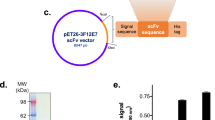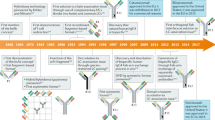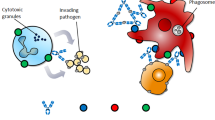Abstract
Disulfide-stabilized Fv fragments of antibodies (dsFv) are molecules in which the VH-VL heterodimer is stabilized by an interchain disulfide bond engineered between structurally conserved framework positions distant from complementarity-determining regions (CDRs). This method of stabilization is applicable for the stabilization of many antibody Fvs and has also been applied to a T-cell receptor Fv. A summary of the design strategy, and the construction and production of various dsFvs and dsFv-fusion proteins is presented. Included in the discussion are the biochemical features of dsFvs in comparison with scFvs, the effect of disulfide stabilization on Fv binding and activity, and various applications of dsFvs and dsFv-immunotoxins for tumor imaging and the treatment of solid tumors in animal models.
This is a preview of subscription content, access via your institution
Access options
Subscribe to this journal
Receive 12 print issues and online access
$209.00 per year
only $17.42 per issue
Buy this article
- Purchase on Springer Link
- Instant access to full article PDF
Prices may be subject to local taxes which are calculated during checkout
Similar content being viewed by others
References
Kohler, G. and Milstein, C. 1975. Continuous cultures of fused cells secreting antibody of predefined specificity. Nature 256: 495–497.
Vitetta, E.S., Thorpe, P.E., and Uhr, J.W. 1993. Immunotoxins: magic bullets or misguided missiles? Trends Pharmacol Sci. 14: 148–54.
Frankel, A.E. 1993. Immunotoxin therapy of cancer. Oncology 7: 69–86.
Brinkmann, U. and Pastan, I. 1994. Immunotoxins against cancer. Biochem. Biophy. Acta. 1198: 27–45.
Pastan, I. and FitzGerald, D. 1991. ecombinant toxins for cancer treatment. Science 254: 1173–1137.
Pastan, I., Chaudhary, V., and FitzGerald, D.J. 1992. Recombinant toxins as novel therapeutic agents. Annu. Rev. Biochem. 61: 331–354.
Bird, R.E., Hardman, K.D., Jacobson, J.W., Johnson, S., Kaufman, B.M., Lee, S.-M., et al. 1988. Single-chain antigen binding proteins. Science 242: 423–426.
Huston, J.S., Levinson, D., Mudgett-Hunter, M., Tai, M.S., Novotny, J., Margolies, M.N., et al. 1988. Protein engineering of antibody binding sites: recovery of specific activity in an anti-dogoxigenin single-chain Fv analogue produced in Escherichia coli . Proc. Natl. Acad. Sci. USA 85: 5879–5883.
Skerra, A. and Pluckthun, A. 1988. Assembly of a functional immunoglobulin Fv fragment in Escherichia coli . Science 240: 1038–1041.
Winter, G., Griffith, A.D., Hawkins, R.E., and Hoogenboom, H.R. 1994. Making antibodies by phage display technology. Ann. Rev. Immunol. 12: 433–455.
Barbas, C.F. III 1995. Synthetic human antibodies. Nature Medicine 1: 837–839.
Burton, D.R. and Barbas, C.F. III 1994. Human antibodies from combinatorial libraries. Adv. Immunol. 57: 191–280.
Raag, R. and Whitlow, M. 1995. Single-chain Fvs. FASEB J. 9: 73–80.
Brinkmann, U., Reiter, Y., Jung, S.H., Lee, B., and Pastan, I. 1993. A recombinant immunotoxin containing a bisulfide-stabilized Fv fragment. Proc. Natl. Acad. Sci. USA 90: 7538–7542.
Reiter, Y., Brinkmann, U., Webber, K., Jung, S.-H., Lee, B.K., and Pastan, I. 1994. Engineering interchain disulfide bonds into conserved framework regions of Fv fragments: improved biochemical characteristics of recombinant immunotoxins containing disulflde-stabilized Fv. Protein Eng. 7: 697–704.
Allured, V.S., Collier, R.J., Carroll, S.F., and McKay, D.B. 1986. Structure of exotoxin A of Pseudomonas aeruginosa at 3.0 Angstrom. Proc. Natl. Acad. Sci USA 83: 1320–1324.
Carroll, S.F. and Collier, R.J. 1987. Active site of Pseudomonas aeruginosa exotoxin A. Glutamic acid 553 is photolabeled by NAD and show functional homology with glutamic acid 148 of diphtheria toxin. J. Biol. Chem. 262: 8707–8711.
Ogata, M., Pastan, I., and FitzGerald, D. 1991. Analysis of Pseudomonas exotoxin activation and conformational changes by using monoclonal antibodies as probes. Infect. Immun. 59: 407–414.
Pastan, I. and FitzGerald, D. 1989. Pseudomonas exotoxin: chimeric toxins. J. Biol. Chem. 264: 15157–15160.
Huston, J.S., Mudgett-Hunter, M., Tai, M.S., McCartney, J., Warren, F., Haber, E., et al. 1991. Protein engineering of single-chain Fv analogs and fusion proteins. Methods Enzymol. 203: 46–88.
Whitlow, M. and Filpula, D. 1991. Single-chain Fv proteins and their fusion proteins. Methods: A companion to Methods Enzymol. 2: 97–105.
Brinkmann, U., Pai, L.H., FitzGerald, D.J., Willingham, M., and Pastan, I. 1991. B3(Fv)-PE38KDEL, a single-chain immunotoxin that causes complete regression of a human carcinoma in mice. Proc. Natl. Acad. Sci. USA 88: 8616–8820.
Benhar, I. and Pastan, I. 1995. Characterization of B1(Fv)-PE38 and B1(dsFv)-PE38: single-chain and disulfide Fv-immunotoxins with increased activity which cause complete remissions of established human carcinoma xenografts in nude mice. Clin. Cancer. Res. 1: 1023–1029.
Friedman, P., McAndrew, S., Gawlak, S., Chace, D., Trail, P., Brown, J., et al. 1993. BR96 sFv-PE30, a potent single-chain immunotoxin that selectively kills carcinoma cells. Cancer Res. 53: 334–339
Pastan, I., Lovelace, E.T., Gallo, M.G., Rutherford, A.V., Magnani, J.L., and Willingham, M.C. 1991. Characterization of monoclonal antibodies B1 and B3 that react with mucinous adenocarcinomas. Cancer Res. 51: 3781–3787.
Chaudhary, V.K., Queen, C., Junghans, R.P., Waldmann, T.A., FitzGerald, D.J., and Pastan, I. 1989. A recombinant immunotoxin consisting of two antibody variable domains fused to Pseudomonas exotoxin.Nature 339: 394–397.
Batra, J.K., Kasprzyk, P.G., Bird, R.E., Pastan, I., and King, C.R. 1992. Recombinant anti-erbB2 immunotoxins containing Pseudomonas exotoxin. Proc. Natl. Acad. Sci. USA 89: 5867–5871.
Wels, W., Harwerth, I.M., Mueller, M., Groner, B., and Hynes, N.E. 1992. Selective inhibition of tumor cell growth by a recombinant single-chain antibody-toxin specific for the erbB-2 receptor. Cancer Res. 52: 6310–6317.
Jung, S.-H., Pastan, I., and Lee, B.K. 1994. Design of interchain disulfide bonds in the framework region of the Fv of the monoclonal antibody B3. Proteins: Structure, Function and Genetics 19: 35–47.
Kabat, E.A., Wu, T.T., Perry, H.M., Gottesman, K.S., and Foeller, C. 1991. Sequences of proteins of immunological interest. 5th ed. U.S. Dept. of Health and Human Services, Public Health Service, National Institutes of Health. NIH publication No. 91-3242.
Glockshuber, R., Malia, M., Pfitzinger, I., and Pluckthun, A. 1990. A comparison of strategies to stabilize immunoglobulin Fv-fragments. Biochemistry 29: 1362–1367.
Carter, P., Presta, L., Gorman, C.M., Ridgway, J.B., Henner, D., Wong, W.L., Rowland, A.M., et al.1992. Humanization of an anti-p185HER2 antibody for human cancer therapy. Proc. Natl. Acad. Sci. USA 89: 4285–4289.
Rodrigues, M.L., Presta, L.G., Kotts, C.E., Wirth, C., Mordenti, J., Osaka, G., et al. 1995. Development of a humanized disulflde-stabilized anti-p185HER2 Fv-beta-lactamase fusion protein for activation of a cephalosporin doxorubicin prodrug. Cancer Res. 55: 63–70.
Young, N.M., MacKenzie, C.R., Narang, S.A., Oomen, R.P., and Baenziger, J.E. 1995. Thermal stabilization of a single-chain Fv antibody fragment by introduction of a disulfide bond. FEBS Lett. 377: 135–139.
Brinkmann, U. and Pastan, I. 1995. Recombinant immunotoxins: from basic research to cancer therapy. ImmunoMethods. 8: 143–156.
Reiter, Y., Brinkmann, U., Kreitman, R.J., Jung, S.H., Lee, B.K., and Pastan, I. 1994. Stabilization of the Fv fragments in recombinant immunotoxins by disulfide bonds engineered into conserved framework regions. Biochemistry 33: 5451–5459.
Kunkel, T.A. 1985. Rapid and efficient site-directed mutagenesis without phenotypic selection. Proc. Natl. Acad. Sci. USA 82: 488–492.
Studier, F.W. and Moffatt, B.A. 1986. Use of bacteriophage T7 polymerase to direct selective expression of cloned gene. J. Mol. Biol. 189: 113–130.
Buchner, J., Pastan, I., and Brinkmann, U. 1992. A method for increasing the yield of property folded recombinant fusion proteins: single-chain immunotoxins from renaturation of bacterial inclusion bodies. Anal. Biochem. 205: 263–270.
Reiter, Y., Pai, L.H., Brinkmann, U., Wang, Q.C., and Pastan, I. 1994. Antitumor activity and pharmacokinetics in mice of a recombinant immunotoxin containing a disulflde-stabilized Fv fragment. Cancer Res. 54: 2714–2718.
Benhar, I., Reiter, Y., Pai, L.H., and Pastan, I. 1995. Administration of disulfide-stabilized Fv-immunotoxins B1 (dsFv)-PE38 and B3(dsFv)-PE38 by continuous infusion increases their efficacy in curing large tumor xenografts in nude mice. Int. J. Cancer 62: 351–355.
Webber, K.O., Reiter, Y., Brinkmann, U., Kreitman, R., and Pastan, I. 1995. Preparation and characterization of a disulfide-stabilized Fv fragment of the anti-Tac antibody: comparison with its single-chain analog. Mol. Immunol. 32: 249–258.
Brinkmann, U., Chowdhury, P.S., Roscoe, D.M., and Pastan, I. 1995. Phage display of disulfide-stabilized Fv fragments. J. Immunol. Method 182: 41–50.
Reiter, Y., Kurucz, I., Brinkmann, U., Jung, S.-H., Lee, B.K., Segal, D.M., et al. 1995. Construction of a disulfide stabilized TCR Fv indicates that antibody and TCR Fv frameworks are very similar in structure. Immunity 2: 281–287.
Bentley, G.A., Boulot, G., Karjalainen, K., and Mariuzza, R.A. 1995. Crystal structure of the beta chain of a T cell antigen receptor. Science 267: 1984–1987.
Reiter, Y. and Pastan, I. 1996. Antibody engineering of recombinant Fv immunotoxins for improved targeting of cancer. Clin. Cancer Res. 2: 245–252.
Reiter, Y., Brinkmann, U., Jung, S.H., Lee, B.K., Kasprzyk, P.G., King, C.R., and Pastan, I. 1994. Improved binding and antjtumor activity of a lecombinant antJ-erbB2 immunotoxin by disulfide stabilization of the Fv foment. J. Biol. Chem. 269: 18327–18331.
Jain, R. and Baxter, L. 1988. Mechanisms of heterogeneous distribution of monoclonal antibodies and other macromolecules in tumors: significance of elevated interstitial pressure. Cancer Res. 48: 7022–7033.
Jain, R. 1992. Physiological barriers to delivery of monoclonal antibodies and other macromolecules in tumors. Cancer Res. 50: 814s–819s.
Yokota, T., Milenic, D.E., Whitlow, M., and Schlom, J. 1992. Rapid tumor penetration of a single-chain Fv and comparison with other immunoglobulin forms. Cancer Res. 52: 3402–3408.
Reiter, Y., Wright, A.F., Tonge, D.W., and Pastan, I. 1996. Recombinant single-chain and disulfide-stabilized Fv immunotoxins that cause complete regression of human colon cancer xenografl in nude mice. Int. J. Cancer. 67: 113–123.
Benhar, I. and Pastan, I. 1995. Cloning expression and characterization of the Fv fragments of the anticarbohydrate monoclonal antibodies B1 and B5 as single-chain immunotoxins. Protein Eng. 7: 1509–1515.
Kuan, C.T. and Pastan, I. 1996. Recombinant immunotoxin containing a disulfide-stabilized Fv directed at erbB2 that does not require proteolytic activation. Biochemistry 35: 2872–2877.
Kreitman, R.J., Chaudhary, V.K., Kozak, R.W., FitzGerald, D.J.P., Waldmann, T.A., and Pastan, I. 1993. Recombinant toxins containing the variable domains of the anti-Tac monoclonal antibody to the IL2 receptor kill malignant cells from patients with chronic lymphocytic leukemia. Blood 80: 2344–2352.
Kreitman, R.J., Chaudhary, V.K., Waldmann, T., Willingham, M.C., FitzGerald, D.J., and Pastan, I. 1990. The recombinant immunotoxin anti-Tac(Fv)-PE40 is cytotoxic toward peripheral blood malignant cells from patients with adult T-cell leukemia. Proc. Natl. Acad. Sci. USA 87: 8291–8295.
Kreitman, R.J., Bailon, P., Chaudhary, V.K., FitzGerald, D.J.P., and Pastan, I. 1994. Recombinant immunotoxins containing anti-Tac(Fv) and derivatives of Pseudomonas exotoxin produce complete regression in mice of an interieukin-2 receptor-expressing human carcinoma. Blood 83: 426–434.
Kreitman, R.J. and Pastan, I. 1994. Recombinant single-chain immunotoxins against T and B cell leukemias. Leukemia & Lymphoma 13: 1–10.
Reiter, Y., Pai, L., Wang, Q.-C., and Pastan, I. 1996. Preclinical characterization of e23(dsFv)-PE38, a recombinant disulfide-stabilized Fv immunotoxin directed at erbB2. Clin. Cancer Res. Submitted.
Kuan, C.T. and Pastan, I. 1996. Improved antitumor activity of a recombinant anti-LewisY immunotoxin not requiring proteolytic activation. Proc. Natl. Acad. Sci. USA 93: 974–978.
Waldmann, T.A., Pastan, I.H., Gansow, O.A., and Junghans, R.P. 1992. The multichain inter-leukin-2 receptor a target for immunotherapy. Ann. Intern. Med. 116: 148–160.
Webber, K.O., Kreitman, R.J., and Pastan, I. 1995 Rapid and specific uptake of anti-Tac disulfide-stabilized Fv by interleukin-2 receptor bearing tumors. Cancer Res. 55: 318–323.
Choi, C.W., Lang, L., Lee, J.T., Webber, K.O., Yoo, T.M., Chang, H.K., et al. 1995. Biodistribution of 18F- and 125I-labeled anti-Tac disulfide-stabilized Fv fragments in nude mice with interieukin 22 receptor-positive tumor xenografts. Cancer Res. 55: 5323–5329.
Kurucz, I., Jost, C.R., George, A.J.T., Andrew, S.M., and Segal, D.M. 1993. A bacterially expressed single-chain Fv construct from the 2B4 T-cell receptor. Proc. Natl. Acad. Sci. USA 90: 3830–3834.
Soo-Hoo, W.F., Lacy, M.J., Denzin, L.K., Voss, E.W., Hardman, K.D., and Krantz, D.M. 1992. Characterization of a single-chain T-cell receptor expressed in E. coli . Proc. Natl. Acad. Sci. USA 89: 4759–4763.
Novotny, J., Ganyu, R.K., Smiley, S.T., Hussey, R.E., Luther, M.A., Recny, M.A., et al. 1991. A soluble, single-chain T-cell receptor fragment endowed with antigen-combining properties. Proc. Natl. Acad. Sci. USA 88: 8646–8650.
Ward, S.E. 1992. Secretion of T-cell receptor fragments from recombinant E. colicells. J. Mol. Biol. 224: 885–890.
Wulfing, C. and Pluckthun, A. 1994. Correctly folded T-cell receptor fragments in the periplasm of E. coli . J. Mol. Biol.242: 655–669.
Kreitman, R.J., Schneider, W.P., Queen, C., Tsudo, M., FitzGerald, D.J., Waldmann, T.A., et al. 1992. Mik-beta 1(Fv)-PE40, a recombinant immunotoxin cytotoxic toward cells bearing the beta-chain of the IL-2 receptor. J. Immunol. 149: 2810–2815.
Chaudhary, V.K., Gallo, M.G., FitzGerald, D.J., and Pastan, I. 1990. A recombinant single-chain immunotoxin composed of anti-Tac variable regions and a truncated diphtheria toxin. Proc. Natl. Acad. Sci. USA 87: 9491–9494.
Batra, J.K., FitzGerald, D.J., Chaudhary, V.K., and Pastan, I. 1991. Single chain immunotoxins directed at the human transferrin receptor containing Pseudomonas exotoxin A or diphtheria toxin: anti-TFR(Fv)-PE40 and DT388-anti-TFR(Fv). Mol. Cell Biol. 11: 2200–2205.
Batra, J.K., Jinno, Y., Chaudhary, V.K., Kondo, T., Willingham, M.C., FitzGerald, D.J., et al. 1989. Antitumor activity in mice of an immunotoxin made with anti-transferrin receptor and a recombinant form of Pseudomonasexotoxin. Proc. Natl. Acad. Sci. USA 86: 8545–8549.
Brinkmann, U., Gallo, M., Brinkmann, E., Kunwar, S., and Pastan, I. 1993. A recombinant immunotoxin active on prostate cancer cells composed of the Fv-region of MAb PR1 and a truncated form of Pseudomonasexotoxin. Proc. Natl. Acad. Sci USA 90: 547–551.
Chaudhary, V.K., Jinno, Y., FitzGerald, D., and Pastan, I. 1990. Pseudomonasexotoxin contains a specific sequence at the carboxyl terminus that is required for cytotoxicity. Proc. Natl. Acad. Sci. USA 87: 308–312.
Seetharam, S., Chaudhary, V., FitzGerald, D., and Pastan, I. 1991. Increased cytotoxic activity of Pseudomonasexotoxin and two chimeric toxins ending in KDEL. J. Biol. Chem. 266: 17376–17381.
Author information
Authors and Affiliations
Rights and permissions
About this article
Cite this article
Reiter, Y., Brinkmann, U., Lee, B. et al. Engineering antibody Fv fragments for cancer detection and therapy: Bisulfide-stabilized Fv fragments. Nat Biotechnol 14, 1239–1245 (1996). https://doi.org/10.1038/nbt1096-1239
Received:
Accepted:
Issue Date:
DOI: https://doi.org/10.1038/nbt1096-1239
This article is cited by
-
Generation and optimization of off-the-shelf immunotherapeutics targeting TCR-Vβ2+ T cell malignancy
Nature Communications (2024)
-
A vector-encoded bispecific killer engager to harness virus-activated NK cells as anti-tumor effectors
Cell Death & Disease (2023)
-
Structural design of tetravalent T-cell engaging bispecific antibodies: improve developability by engineering disulfide bonds
Journal of Biological Engineering (2021)
-
Discovery of a novel IL-15 based protein with improved developability and efficacy for cancer immunotherapy
Scientific Reports (2018)
-
Production and quality control assessment of a GLP-grade immunotoxin, D2C7-(scdsFv)-PE38KDEL, for a phase I/II clinical trial
Applied Microbiology and Biotechnology (2017)



